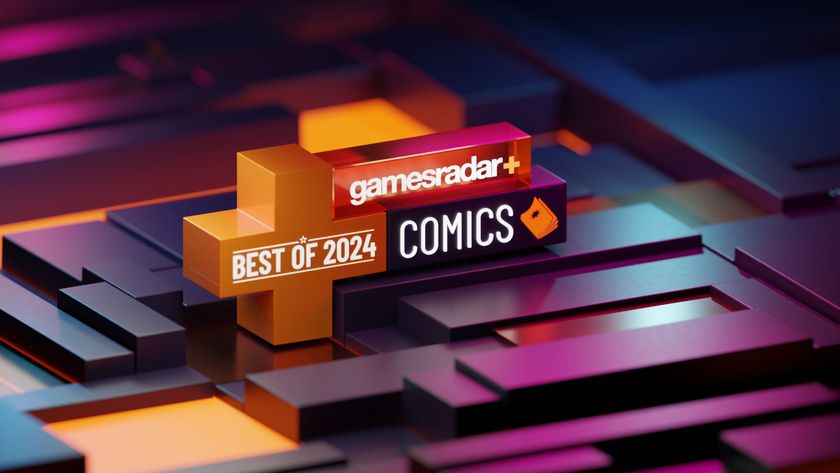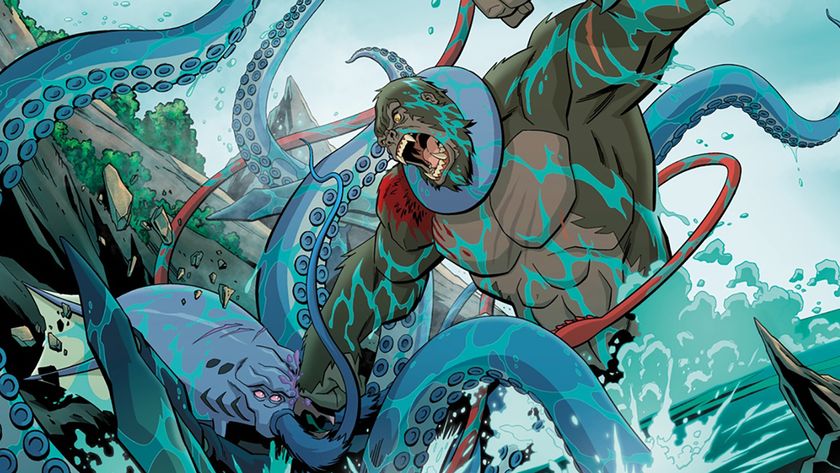Best Shots review: Invincible holds up as a modern coming-of-age story for superheroes
Thanks to Robert Kirkman's naturalistic dialogue and Cory Walker's unique art

With an Invincible animated series out now on Amazon Prime, Newsarama takes a look back at where it all started, with the first two trade collections of Invincible – Family Matters and Eight is Enough.
The sitcom-style volume names help set the tone that Robert Kirkman, Cory Walker, and later Ryan Ottley hit with Invincible. Each issue focuses on our hero, Mark Grayson, and his handling of his superpowers. The world around Mark resembles that of Marvel and DC's universes; relatively normal, but with the existence of super-powered individuals considered commonplace. For Mark, this has always been true – his dad is the Superman-esque Omni-Man. So when Mark discovers his powers have arrived when he takes out the trash he responds excitedly, "It's about time."
Written by Robert Kirkman
Art by Cory Walker, Bill Crabtree, Ryan Ottley, Terry Stevens, Matt Roberts, Tony Moore, Mark Englert, Erik Larsen, Dave Johnson, and Cliff Rathburn
Letters by Robert Kirkman
Published by Image Comics
'Rama Rating: 8 out of 10
Unlike Spider-Man, or Ms. Marvel, Static, or the Flash, Mark Grayson doesn't have to hide himself from his family or learn to use his powers on his own. He isn't surprised or scared by the arrival of his powers. While the relative lack of a 'secret identity' may feel less profound after Tony Stark declaring "I am Iron Man" in the 2008 film, it still causes a pretty dramatic shift in the way Mark's story plays out compared to other superheroes. Because Mark knows he's going to get powers, knows superheroes, knows how the business work, he treats superheroing as a job. There is no "with great power, comes great responsibility" here. In that way, especially in these first two arcs, Invincible is less a book about a hero's journey, as much as it is a standard coming-of-age story with a more colorful type of on-the-job training.
With the focus less on a thematic constant (or even a strong plot), it's the characters and humor that shine through in Invincible. These first two arcs focus primarily on Mark's relationship with his father, Nolan, and Mark's teammates on the Teen Team. Robot, Rex-Splode, and Dupli-Kate all have their moments, but it's Mark's friendship and budding crush on Samantha Eve Wilkins (aka Atom Eve) that gets the strongest development here. Still, Eve isn't particularly multi-dimensional, serving more as an attractive girl that Mark gets to talk with more than once.

Robert Kirkman's dialogue feels very naturalistic, capturing the barbs and sighs that fit the high-school environment. Artist Cory Walker makes all these interactions come through strong, with a looser illustration style that allows for heightened expressions that work well in this world. With the super-powered individuals flying to-and-fro, Walker balances the dynamic action with well-crafted scenes of normalcy. The use of repeated panels helps to create pauses in the dialogue for both dramatic and comedic effect. Walker fits in visual humor such as parodic brands like RAP instead of GAP, along with cameos by Charlie Brown and Jay & Silent Bob. Perhaps most notable, Mark Grayson's school is named after actor Reginald VelJohnson and the school's principal bears more than a passing resemblance to the actor.
Walker's expressive style is not always the most detailed, oftentimes having a sketch-like quality. While the big moments come through, the lack of detail can result in some loss of spatial geography, especially in the fight scenes. The inconsistency in line-art is offset by Bill Crabtree's coloring, creating shading and texture on the characters that is otherwise missing. Crabtree's colors are responsible for Invincible's distinctive look, with a saturated palette that makes even the most mundane setting look interesting. Together, Walker and Crabtree create dozens of new hero designs. Superheroes are known for their iconography, whether it's Spider-Man's webbed red-and-blue, Superman's golden crest, or Batman's ears. Each hero has a silhouette and a design that makes them instantly memorable. Walker and Crabtree do that repeatedly throughout these opening issues, making sure that Invincible, Omni-Man, Atom Eve, and others all are immediately recognizable on the page.

The second volume, Eight is Enough, builds upon the first and starts to develop a more cohesive plot as Mark grows into his role as protector. This starts off subtly, with Mark facing off against an alien foe that his father has fought multiple times. Mark actually chooses to talk to the alien, discovering that his would-be foe is actually testing the planet per a scheduled request.
Comic deals, prizes and latest news
Get the best comic news, insights, opinions, analysis and more!
The third issue in the second arc sees the introduction of the Guardians of the Globe, and a bevy of guest artists. Terry Stevens, Matt Roberts, Tony Moore, Mark Englert, Erik Larsen, Dave Johnson, and Cliff Rathburn all contribute to the introduction of these Justice League knock-offs before Walker and Kirkman deliver what is the first big shock in a series that would prove to be full of them. It's a moment that signals a dramatic shift in tone for the series, and the follow-up issue delivers a visual change as Ryan Ottley takes over art duties from Walker. Ottley's lines are a little firmer in quality, with more crisp detail, but still retaining the expressionism of Walker's work. Crabtree's coloring helps with the transition between artists, ensuring a strong visual cohesiveness.
While neither of these volumes is particularly spectacular, they both establish the characters and this world in an engaging fashion nearly 20 years after their debut. The parody doesn't feel quite as fresh, especially with a variety of deconstructionist takes on superheroes already in the mainstream (see The Boys, Batman v. Superman: Dawn of Justice, Harley Quinn), but Kirkman, Walker, Crabtree, and Ottley make for a fantastic team and the slower, episodic storytelling allows readers to really get to know the characters.
Mark Grayson isn't a big dreamer, he doesn't have lofty goals or an incredibly strong moral driver. He's an average kid (with superpowers), and that's what makes him and his story worth reading.
Check out our list of the best non-Marvel or DC comic book superheroes.

Robert is a Los Angeles-based comics journalist and writer (formerly Omaha, Nebraska). He currently writes for Newsarama and Adventures in Poor Taste.






















